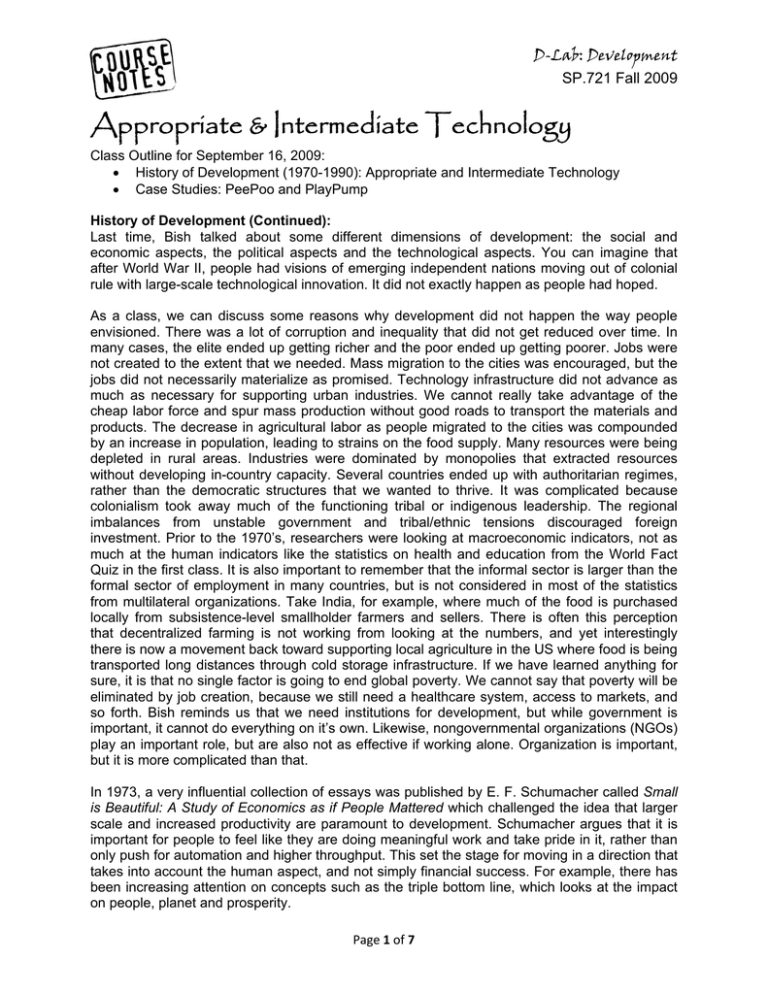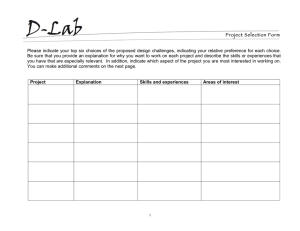
D-Lab: Development
SP.721 Fall 2009
Appropriate & Intermediate Technology
Class Outline for September 16, 2009:
• History of Development (1970-1990): Appropriate and Intermediate Technology
• Case Studies: PeePoo and PlayPump
History of Development (Continued):
Last time, Bish talked about some different dimensions of development: the social and
economic aspects, the political aspects and the technological aspects. You can imagine that
after World War II, people had visions of emerging independent nations moving out of colonial
rule with large-scale technological innovation. It did not exactly happen as people had hoped.
As a class, we can discuss some reasons why development did not happen the way people
envisioned. There was a lot of corruption and inequality that did not get reduced over time. In
many cases, the elite ended up getting richer and the poor ended up getting poorer. Jobs were
not created to the extent that we needed. Mass migration to the cities was encouraged, but the
jobs did not necessarily materialize as promised. Technology infrastructure did not advance as
much as necessary for supporting urban industries. We cannot really take advantage of the
cheap labor force and spur mass production without good roads to transport the materials and
products. The decrease in agricultural labor as people migrated to the cities was compounded
by an increase in population, leading to strains on the food supply. Many resources were being
depleted in rural areas. Industries were dominated by monopolies that extracted resources
without developing in-country capacity. Several countries ended up with authoritarian regimes,
rather than the democratic structures that we wanted to thrive. It was complicated because
colonialism took away much of the functioning tribal or indigenous leadership. The regional
imbalances from unstable government and tribal/ethnic tensions discouraged foreign
investment. Prior to the 1970’s, researchers were looking at macroeconomic indicators, not as
much at the human indicators like the statistics on health and education from the World Fact
Quiz in the first class. It is also important to remember that the informal sector is larger than the
formal sector of employment in many countries, but is not considered in most of the statistics
from multilateral organizations. Take India, for example, where much of the food is purchased
locally from subsistence-level smallholder farmers and sellers. There is often this perception
that decentralized farming is not working from looking at the numbers, and yet interestingly
there is now a movement back toward supporting local agriculture in the US where food is being
transported long distances through cold storage infrastructure. If we have learned anything for
sure, it is that no single factor is going to end global poverty. We cannot say that poverty will be
eliminated by job creation, because we still need a healthcare system, access to markets, and
so forth. Bish reminds us that we need institutions for development, but while government is
important, it cannot do everything on it’s own. Likewise, nongovernmental organizations (NGOs)
play an important role, but are also not as effective if working alone. Organization is important,
but it is more complicated than that.
In 1973, a very influential collection of essays was published by E. F. Schumacher called Small
is Beautiful: A Study of Economics as if People Mattered which challenged the idea that larger
scale and increased productivity are paramount to development. Schumacher argues that it is
important for people to feel like they are doing meaningful work and take pride in it, rather than
only push for automation and higher throughput. This set the stage for moving in a direction that
takes into account the human aspect, and not simply financial success. For example, there has
been increasing attention on concepts such as the triple bottom line, which looks at the impact
on people, planet and prosperity.
Page 1 of 7
Intermediate Technology:
From this shift in perception toward more holistic approaches, what started to emerge was this
concept of intermediate and appropriate technologies. There are several ways in which
technologies are considered to be intermediate: 1) in price, and 2) in time, as some
technologies are meant to be transitional and support people in moving from manual labor using
hand tools to large-scale mechanized technology. Take pressing peanut oil as an example,
where the existing technologies might be an indigenous method of pressing oil by hand, which
is both time-consuming and labor-intensive, and mechanized oil presses at the other extreme,
which may require a very high capital investment of thousands of dollars and infrastructure such
as electricity. In this situation, an intermediate technology might be a $200 ram press that uses
a lever to press out oil with more force than current manual methods, helping to improve the
speed and output of the production process. Similarly, a $375 press that produces 500 bricks a
day can be considered intermediate technology in helping with the transition from molding bricks
by hand to using an industrial brick maker that costs $23,000 and produces 10,000 bricks a day.
Another example of intermediate technology is the treadle
pump, which enables farmers to provide a greater
amount of water to their plants more easily compared to
watering by bucket, while requiring much less
infrastructure than constructing irrigation dams and pipes.
Other examples include a mixed method of making
roofing tiles that utilizes both motorized machinery and
manual work. One workshop that is using this method is
run by a cooperative of women who have been widowed
and socially ostracized. These women have been able to
sell every tile they make and transport to market,
enabling them to support themselves and be
independent. In this case, one of the immediate
limitations is actually transport rather than production,
since the cooperative is at the bottom of a hill and the
women have to get the tiles to market.
Courtesy of Alfinio Flores. Used with
permission.
There is an interesting niche here, as intermediate technologies work when it is too expensive
for mass manufacturers to get their larger-scale technologies to certain communities because of
diminishing economies of scale. Intermediate technologies are more affordable and can be
more decentralized, helping to bridge that last mile of distribution. Additionally, where specific
skilled labor is required, intermediate technologies may have an important place. For example,
you can imagine that it may not make sense to use a mechanical combine for flower picking.
Appropriate Technology:
What makes a technology appropriate? Students threw out areas of consideration such as:
• Need
• Maintainability, reparability
• Affordability
• Quality
• Benefits, such as increased
• Local materials, local production
production
• Low ecological impact
• Cultural acceptability,
appropriateness for social context
• Fit within infrastructural environment
• Transparency, understandability
• Ease of use, match to local skills
• Durability, reliability
Page 2 of 7
Connecting back to the roots of this movement from Small is Beautiful, the traditional definition
of appropriate technology also includes creating meaningful jobs, using decentralized renewable
energy, small-scale, and open source as part of its ethos. Each of these areas could be
explored in much more depth than we have time for today. If you are interested in continuing the
discussion, take a look at the D-Lab: Design course that is offered in the spring.
Photo courtesy of the National Science
Foundation.
An example of appropriate technology is the sari cloth filter.
It was found that the transmission of cholera could be
reduced by 50% during an outbreak if people fold a sari
(women’s clothing in India) several times and use it to filter
water. This is something that is low-cost, simple, locally
available, easy to implement and yet has an incredible
potential for positive impact – what is important here is
knowledge transfer. Also, every technology has its limits so
there is a need to communicate the limits of the sari cloth
filter as well. Cholera bacteria is much bigger than other
bacteria and viruses, so this type of filtration cannot ensure
that the water is safe to drink.
Another commonly cited example of appropriate
technology is the pot-in-pot evaporative cooler. It works by
having a pot within a pot, separated by a layer of dirt that
can be moistened, so the interior is cooled as the water
evaporates. In these pots, vegetables can last 2-3 weeks
without refrigeration instead of just a few days, enabling
households to store food longer. The coolers also enable
farmers to wield more negotiating power and command
better prices in the market by helping to reduce the
pressure to sell before the vegetables go bad. Local
potters can be trained to make these “desert Photos © Rolex Awards for Enterprise.
refrigerators,” but the key word is “desert” because this All rights reserved. This content is
technique works much better in areas of low humidity. The excluded from our Creative Commons
pot-in-pot coolers do not work as well during the wet license.For more information, see
http://ocw.mit.edu/fairuse.
season or in certain climates, and can be difficult to
transport. In Nigeria, a teacher from a family of potters
named Mohammed Boh Abba developed these coolers utilizing locally available materials and
traditional knowledge. There are now tens of thousands of these pots in Nigeria and other parts
of the world, and the teacher has also done well for himself with a university appointment and
several awards.
The definition of appropriate can also change based what support infrastructure is available. For
example, Whirlwind makes wheelchairs out of materials that may not have fit into the traditional
definition of locally available – yet if something is available locally, then it is locally available.
The bearings in Whirlwind’s wheelchairs are actually old bearings from ceiling fans, but they can
be sourced locally instead of imported. Whirlwind engages local labor in taking advantage of
locally available resources, rather than limiting themselves to raw materials that can be grown or
dug up. There is certainly a lot of skill from indigenous manufacturing, but sometimes the
existing infrastructure can support more and we do not have to constrain ourselves to the
traditional definition of appropriate. Plastic sheets may soon start to be considered a locally
Development through Dialogue, Design & Dissemination
available material, as new supply chains are being built up and communities are starting to
accumulate more plastic waste to recycle into sheets.
There are many other examples of organizations taking advantage of the evolving infrastructure,
or even developing their own infrastructure to help support certain technologies. When solidstate white LEDs (light-emitting diodes) first came out, they were about $12 each. An
organization called Light Up the World would purchase lower-quality white LEDs, which might
have had a lifetime of around 10,000 hours instead of over 20,000 hours, and then assemble
small circuit boards locally to make small lights for housing and street-side vendors. Iqbal
Quadir started a movement called Grameen Phone to provide phone service in rural
Bangladesh. Interestingly, he had to start a telecom company to do it because the necessary
infrastructure was not there yet. It is also important to consider different types of infrastructure,
such as the financial infrastructure. At the time that Grameen Phone started, cell phones were
not particularly cheap so they needed a method of financing, which is where microfinance came
in. In order to cater to people living in poverty, it is important to understand their cash flows.
Harish Hande, founder of SELCO Solar Company in India, argues that every technology can
become affordable with the right financing. He often shares the story of his interview with a
woman who said that she could not possibly pay the full price of 300 rupees a month for a small
solar photovoltaic system, but she could pay 10 rupees a day. Harish Hande turns the notion
that solar energy is expensive for the poor on its head, saying that the rich are the ones who
need subsidies. A big takeaway here is that if we can get the supply chain in place and make
the price affordable, our technology may become more appropriate. While there is a lot of room
for improvement within the appropriate technology movement, there are also many positive
lessons that we can retain.
Case Studies:
Next, the class discussed some technologies from the readings, starting with the PeePoo bag
and the PlayPump. Students started by responding to a quick, informal survey about their
impressions of the technologies on a scale from 1 to 5, with 5 being an excellent idea. Most
people thought the PeePoo was around 3 and the PlayPump fell at about 4. The class then
discussed what they liked and did not like about the technologies, based on the information that
they had.
PeePoo:
Amy wondered how many classes at MIT get to talk about something
called PeePoo. Students seemed to have mixed feelings about the
technology overall. One person thought that one-time-use bags would
required a lot of distribution, upkeep and maintenance cost. Another
student pointed out that if the bags are being used in slums, the
population tends to be more dense, potentially making distribution easier.
Someone came back with the argument that full-compliance in use is
important for preventing disease transmission, particularly in crowded
areas (in surveys, 85% of people said they would use the PeePoo). When
Amy asked how many students in the class would use PeePoo bags for
the next week, only 5 raised their hands. It is especially important to
consider the cultural context and the use of bags may not be appropriate
Photo courtesy of
in some communities, especially for the women. In some slums, however, Peepoople
people are already defecating plastic bags and throwing them away as (info@peepoople.com).
“flying toilets.” People may already be used to open defecation and less
self-conscious about privacy. There are possibilities of finding situations where these bags can
be effective, but the creators may not be thinking in that way. Advertising has compared the
bags to having the same impact and being as revolutionary as computers. One student was
Page 4 of 7
frustrated with the way PeePoo presented itself in the brochure, and how it kept saying that the
bags were affordable without ever mentioning the actual price. A few thought the PeePoo’s
impact was better than nothing, and liked the opportunity for income generation by selling the
waste as fertilizer. Someone else was concerned that the bags are made out of petroleum
products, which may not be sustainable in the long-term. Many students in the class agreed that
the PeePoo may work better as a transition technology, with the eventual goal of putting in
latrines and sewer systems.
PlayPump:
Many students were amused that everyone says the PlayPump can make it less work to pump
water, since people still have to lift the same amount of water, plus now there is additional
friction and moment of inertia from the roundabout structure to take into account. It may be nice
for children to have something new to play on, but not if they have to “play” all day instead of
going to school. If no children are around, how does the community pump water? There have
been photos of women having to turn the heavy roundabout by hand instead. One student
asked if the PlayPump could be hooked up to livestock instead? Another was concerned about
the high capital investment involved, particularly if the aquifer ends up running dry or the
groundwater ends up being contaminated like in Bangladesh where there is arsenic. Amy
clarified that PlayPumps are typically installed where hand pumps are already being used with
existing naturally-replenishing aquifers, so people would have the same source of water for
better or worse. Maintenance of the PlayPump is another issue, however, since many of the
parts are specialized and may have to be shipped in. One person was relieved that at least it
seems like user error with PlayPumps cannot really make the situation worse, unlike with the
PeePoo bags. Someone else commented that this technology appears very inefficient with so
much extra material, then was reminded that the image of having cute children running around
is attractive to donors and the money is earned through advertising. PlayPumps may be
considered hip, which is good for design magazines, but do they really work well for the
communities that have them installed? People who are interested in learning more should watch
the following video update called “Troubled Water,” which shows the fate of PlayPumps now:
http://www.pbs.org/frontlineworld/stories/southernafrica904/
Page 5 of 7
Schematic from the PlayPump website
1) Roundabout 2) Borehole pump 3) Underground aquifer 4) Polyethelene tank 5) Tap
6) Excess water (overflow) returned to borehole 7) Landscape billboard screen for advertising
© PlayPumps. All rights reserved.
This content is excluded from our Creative Commons license. For more information, see http://ocw.mit.edu/fairuse.
Below are a few guiding questions within different dimensions of analysis, which we used in our
class discussion. Comments are in italics.
Technology:
• Does the technology work?
o If so, does the technology work all the time?
o Is it susceptible to user error?
For example, the PeePoo website says that people have to avoid
touching certain parts of the bag, which may be hard to do in practice.
• Does the technology address the problem?
o Sometimes a technology addresses the problem only partially for certain
situations. If this is the case, what aspects of the problem are addressed by the
technology? What aspects are not addressed?
• Can the technology be maintained locally?
o The PeePoo will need the right supply chain to be in place for distribution and
collection. People will be more incentivized to market the bags and help maintain
the system if they can make decent money from doing so.
Context:
• Does using the technology require behavior change?
o This is one of the most difficult barriers to address for technology adoption,
especially if the behavior change requires more time or effort. People living in
poverty are busy enough trying to survive and already have high demands on
their time and limited resources. Remember how Bish said that some people
Page 6 of 7
choose not to look for a job in the morning so that they will not have to eat as
much that day. If they get a job, then they can eat more and work more, but
otherwise they have to conserve energy. There are many trade-offs to consider.
Try to understand people’s rational decision-making and their framework for
doing so.
Cost:
• Is the technology affordable?
o PeePoo says it is aiming for a cost of 2-3 cents a bag, but projections are often
too optimistic (take the example of the $100 laptop) so this could actually mean
3-4 cents a bag. If we give them the benefit of the doubt and use a cost of 3
cents in our estimates, this comes out to about $200 a year for a 5-person
household, which is actually enough to build a decent latrine. Remember to look
at the numbers carefully because people can publicize statistics in a way that
sounds more attractive.
o Let’s try another example. PlayPumps cost about $7,000 each, according to their
publicity, although the actual cost may be higher. Their average flow rate is
supposedly about 400 gallons per hour, which may sound high, but it seems
much lower if you look at the per minute rate (which is less than a treadle pump’s
flow rate). Say an average person requires a 5 liter bucket of water each day.
How many people could a PlayPump support? What will the cost come out to be
per person?
• Does the technology have recurring costs?
• Does the technology provide income? If so, for whom?
The case studies reminded us to be wary of anecdotal evidence. People tend to be polite, so we
cannot always assume that they are giving real feedback. Someone being interviewed about the
PeePoo is likely to say nice things about it if the interviewers are foreigners who came all the
way to their community to bring these bags. Keeping this in mind, we need to be careful about
managing the temptation to hype something up. Not only is it embarrassing if the hype turns out
to be undeserved; the real negative impact is that it is irresponsible and can waste resources.
PlayPumps received over $16 million, which could have gone to programs that worked. This
work is hard, and there have been many projects that got a lot of hype but did not quie deliver
on what was promised, such as the LifeStraw. Let’s try to be humble and true about the way
that we share the work we are doing, instead of promoting an ethos of praising untested
technologies. We can be excited and say that our design is awesome and works, if it is really
awesome and really works. Better yet, we can focus our attention on working hard with our
community partners to have a better chance of building awesome projects that work well.
Page 7 of 7
MIT OpenCourseWare
http://ocw.mit.edu
EC.701J / 11.025J / 11.472J D-Lab I: Development
Fall 2009
For information about citing these materials or our Terms of Use, visit: http://ocw.mit.edu/terms.




